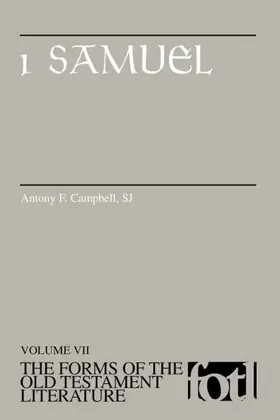

1 Samuel
in Forms of the Old Testament Literature
Pages
350 pages
Publisher
Eerdmans
Published
6/1/2003
ISBN-13
9780802860798
1 Samuel is Volume VII of The Forms of the Old Testament Literature, a series that aims to present a form-critical analysis of every book and each unit in the Hebrew Bible. Fundamentally exegetical, the FOTL volumes examine the structure, genre, setting, and intention of the biblical literature in question. They also study the history behind the form-critical discussion of the material, attempt to bring consistency to the terminology for the genres and formulas of the biblical literature, and expose the exegetical process so as to enable students and pastors to engage in their own analysis and interpretation of the Old Testament texts.
Antony Campbell’s valuable form-critical analysis of 1 Samuel highlights both the literary development of the text itself and its meanings for its audience. A skilled student of the Hebrew scriptures and their ancient context, Campbell shows modern readers the process of editing and reworking that shaped 1 Samuel’s final form. As Campbell’s study reveals, the tensions and contradictions that exist in the present text reflect a massive change in the way of life of ancient Israel. Samuel, the first prophet, here emerges to preside over the rise of Saul, Israel’s first king, to be the agent of Saul’s rejection, and to anoint David as Israel’s next king and the first established head of a royal dynasty. The book of 1 Samuel captures the work of God within this interplay of sociopolitical forces, and Campbell fruitfully explores the text both as a repository of traditions of great significance for Israel and as a paradigm of Israel’s use of narrative for theological expression.
Reviews
Campbell is sensitive to issues of the book’s development without losing sight of
the fact that this text is a part of the Jewish-Christian canon.
Campbell is sensitive to issues of the book’s development without losing sight of
the fact that this text is a part of the Jewish-Christian canon. Normally, the Old Testament
Library is a good theological series
Form-critical analysis that attempts to identify the genre, setting, and literary features of the narratives.
[Full Review]
In the preface to this first of two form-critical commentaries on the books of Samuel, Campbell wrestles with what he calls process and product readings of books such as Samuel, methods otherwise called diachronic and synchronic. He notes that today we do not necessarily seek the right interpretation but one that is adequate and responsible. In the commentary itself the author promises to deal with larger units of sense or story and to interpret substantially the text as it now exists. The final chapter summarizes what the author (sometimes assisted by Mark O�Brien) has published elsewhere about diachronic issues dealing with 1 and 2 Samuel: the Ark Narrative, the so-called Prophetic Record, the editions of the Deuteronomistic History, and the like. The only surprises for me here are his denial of the existence of a precanonical composition called the History of David�s Rise and his sense that the concern of the Ark Narrative is foreign to Christian theology, since Christianity allegedly is free from any concern about God abandoning his people.
[Full Review]
The stories of 1 Samuel, full of intrigue and violence and genuine piety, have provoked and stymied readers for centuries. Today�s publishing bonanza centering on David and the evolution of the Deuteronomistic History and its constituent parts has only accentuated that fascination. Campbell�s ne w commentary, a welcome development of the author�s co-written work Unfolding the Deuteronomistic History, deservedly takes its place in the long line of works by authors bearing names as Driver, Wellhausen, McCarter, Stoebe, and Brueggemann. Following the format of the Forms of the Old Testament Literature series, this volume opens with a chapter on �The Overall Shape of 1-2 Samuel,� concludes with an analytical chapter on �Diachronic Dimension: From Past Texts to Present Texts� exploring the stages of the book leading to its final state within the Deuteronomistic History and beyond, and in the middle includes eight chapters, each addressing the major units of the book. An �Introduction� offering ba sic orientations to form criticism and the content of 1-2 Samuel guides both novice and scholarly readers in the volume�s use. A succinct, helpful glossary of thirty-two genres concludes the work.
[Full Review]


